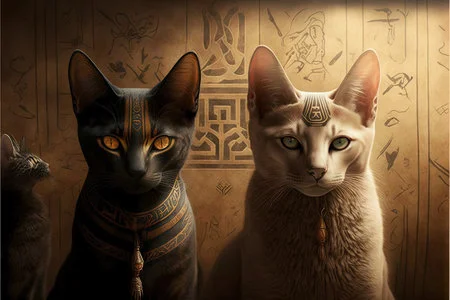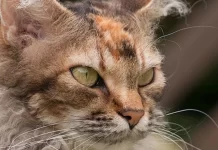Last Updated on August 24, 2023 by Fumipets
Discovering the Fascinating World of Egyptian Cat Breeds
Egyptian cat breeds have captivated people for centuries with their mysterious allure and connection to ancient history. These feline companions carry a special significance and charm that resonates with cat lovers worldwide.
Let’s explore the unique characteristics and cultural importance of Egyptian cat breeds in this summary.
Exploring the Legacy of Egyptian Cat Breeds
Egyptian cat breeds hold a special place in both history and modern-day cat culture. From the symbolism of ancient Egyptian deities to their unique physical traits, these feline companions continue to intrigue and enchant cat enthusiasts around the world.
Whether it’s the striking appearance of the Egyptian Mau, the textured coat of the Abyssinian, or the hairless charm of the Sphynx, these breeds bring a touch of ancient Egypt into our lives.
Egyptian Cats
Egyptian cat breeds are associated with the Egyptian deity Bastet, ancient tombs, and hieroglyphic writing. Fine felines from this area were nevertheless cherished by pharaohs, despite the fact that they weren’t formally worshipped as myth would have us think. In fact, many of them were buried beside them. In actuality, the cat mummies from ancient Egypt are domestic cats, not wild ones.
Does this imply that all cats originate in Egypt? Not quite. In fact, not even all varieties deemed Egyptian originate there! (More on it in a minute).
Uncovering the Mystery of Egyptian Cat Breeds
A cat DNA test company called Basepaws employs Rowyn Rose as a scientific communication expert. According to her, the first archeological dumps containing both cat and human bones were discovered 9,500 years ago in Cyprus, south of Turkey, or around 5,000–6,000 years before the ancient Egyptian civilization existed.
All domestic cats, including purebred and feral cats, are derived from the North African/Near Eastern subspecies, F.s. libyca, according to genetic research, explains Rose. Domestication most likely took place in western Asia’s Fertile Crescent (the Levant, southern Turkey, and Iraq).
Because selective cat breeding has only been practiced by humans for a very little period of time, it has not yet completely replaced the far older tradition of cats reproducing freely on their own, according to Rose. As a result, contemporary cats seldom have ancestors of a certain breed.
As a result, Rose’s description of the origins of Egyptian cat breeds as mutts is accurate. “The selective breeding of cats for certain desirable traits—primarily aesthetic in nature—has a very short history of only 50-100 years, so our concept of the purebred or pedigree cat is a very new one,” she claims. This indicates that, even among well-established pedigree breeds, the genetic makeup of cats has remained remarkably diversified.
Now that we’ve completely peaked your interest, let’s examine more closely at various Egyptian cat breeds, mixed breeds, and one fake!
Egyptian Mau

The Egyptian term for cat is mau, which is pronounced MAH-oo and sometimes has a meow-like sound. Only 7,000 of the distinctively spotted Egyptian maus, a rare purebred, are officially registered with the Cat Fanciers’ Association (CFA).
All historical evidence points to the mau as being Egyptian, but according to Rose, DNA research shows that the breed as we know it now really has a strong European and North American heritage. “Based on genetic analysis, the mau is very closely related to the Maine coon, Korat, Turkish van, and American Turkish Angoras (not native Turkish Angoras),” the author continues.
Nevertheless, maus have roamed the nation that bears their name for many centuries. The Jakarta Post claimed in 2018 that archaeologists had discovered a 6,000-year-old pyramid complex where they had discovered countless ancient Egyptian maus, both in mummies and statue form.
Egyptian mau cats are charming, perceptive, and affectionate, loving their human family and often one person in particular. They like scanning their surroundings from a height, so make sure your cat tree is high. They have been known to leap to heights of up to 6 feet with ease. Oh! They also like the water!
Shirazi

The Shirazi’s complete history is uncertain, but according to Rose, the widely believed myth is that an Italian called Pietro Della Valle initially brought this hybrid breed to Europe in the 1620s as a memento from Persia, or what is now Iran. Shirazis may not be the oldest breed of Egyptian cat, despite the fact that they most likely have mau DNA in their mixed lineage.
The first cat exhibition in history was held in London in 1871, and Persian cats were shown there and awarded best in show. Shirazis, however, are now regarded as crossbreeds and are not listed with any organizations, which is interesting.
Persian ancestry is evident, particularly in their long, flowing, silky coats that come in a variety of patterns including tabby and mixed bronze and golden. Shirazis are described as intelligent, lively, and friendly cats with a laid-back temperament and an extreme fondness for cuddles by the Egyptian Mau Rescue Organization.
Nile Valley Egyptian Cat

Another mixed breed cat, this one is a challenge to identify. Nile Valley Egyptian cats are thought to be native Egyptian maus, and according to Rose, some feline scientists believe they represent the’missing link’ between an ancestor of the completely domesticated cat and an African wildcat. They are regarded as one of the few little spotted cats in existence today that are not domesticated.
According to Rose, there are several tales of difficulties they encounter in Egypt, where they mostly seem to live as stray cats and struggle in cat colonies. The Nile Valley Egyptian Foundation, a committed NGO, tries to save these cats and find them permanent homes in the United States.
They have inquiring minds and gentle temperaments comparable to maus, but they may need a bit more love (okay, a lot more!) and positive reinforcement training to integrate well with their new homes.
Chausie

“The Latin name for the jungle cat, felis chaus,” explains Rose, “derives from the term chausie (pronounced CHOW-see). “The chausie’s massive size—ranging from 8 to 16 pounds, making them among the top 5 largest domestic cats in the world—has sparked some interesting comparisons to the breed, including that they look like a “Abyssinian on steroids” and are the cat equivalent of Arnold Schwarzenegger.”
The International Cat Association (TICA) claims that these hybrid jungle-domestic cats traveled the globe and first appeared millennia ago in places like Southeast Asia and India. However, the two were intentionally bred for the first time in 1990. In 1995, the chausie obtained foundation registration status with TICA, and in 2013, it attained championship status.
A curious and shrewd chausie will explore every crevice. He will be an energetic pet and, with the correct harness, most likely the ideal adventure cat! Many cats are satisfied to sleep for the most of the day, but not this adorable one. He enjoys playing with interesting toys and nuzzling people’s heads.
Abyssinian

I believe the best breed of Egyptian cats is this one. Featured on papyrus scrolls, ancient treasures, and mastaba (the “houses of eternity”). regarded as the goddess Bastat in feline form. However, they are not native Egyptians. Whhaaaat?
“According to the CFA, recent genetics research provides insight into the possible origin of the Abyssinian breed, tracing it to the coast of the Indian Ocean and areas of Southeast Asia,” adds Rose. Although the Abyssinian breed was developed in England, colonists and traders may have stopped at Calcutta, the main port for the Indian Ocean, on their way to that nation and others. Additionally, the term “Abyssinian” originates from Abyssinia, which is now Ethiopia in current times.
No big deal. This elegant companion will always serve as our idea of a royal feline, and there’s a good reason why they’re one of the most well-liked cat breeds worldwide. Cat skeptics who assert that cats are reclusive have clearly never met the sociable butterfly from Ethiopia. They will follow you about, almost dog-like in their devotion to their favorite people and insatiably curious about everything that is happening. This intelligent, energetic cat will also pounce a lot while engaging in combat with interactive toys.
Savannah

Given that she is an uncommon mixed-breed cat, many people have questions about her. Technically not an Egyptian cat either, she first arrived on the scene in the middle of the 1980s as a hybrid of a domestic Siamese cat and a wild African serval cat; her name, Savannah, is a nod to the grassy plains that servals call home.
It’s essential to keep a Savannah busy since she is a very intelligent kitty. Have you heard of cat clicker training? She is a strong candidate for that as well as other hobbies that don’t appear to include cats, such indoor treadmills or hiking. To accommodate her need for unrestrained adventures, construct a multi-level catio. Savannah cats are also quite sociable and form strong bonds with both people and other animals.
Another intriguing aspect is this. There are presently no documented genetic health disorders specifically linked to this breed of cat, according to Rose, despite the possibility of genetically inherited health issues existing in all cats.
Sphynx

Aha! You knew we would ultimately have to confront this man! Although sometimes mistaken for an Egyptian hairless cat breed, the Sphynx is a cute impostor from the Canadian Arctic. Sphynx cats were unintentionally introduced to Canada, according to Rose. Prune, a hairless kitten born in 1966 in Toronto to a black and white domestic cat named Elizabeth, was one of the earliest progenitors of the well-known breed.
A breed of hairless cat, formerly known as the Canadian hairless cat, was developed by breeding Prune with a European Devon rex. However, the name was altered to Sphynx because of how much cats in Egyptian mythology resembled them. Myth debunked! The adorable wrinkled cat we know today was produced by further breeding to address health problems. They enrolled in the 2002 CFA Championship class.
Another misconception about cats has been dispelled: they are not entirely hypoallergenic (no cat is, in fact). They don’t have hair, yet their saliva still contains the allergen Fel d 7.
Even if they like stylish sweaters, just because they’re cuddly doesn’t mean they’re solely trying to keep warm. Sphynx cats are dedicated to their owners and may experience separation anxiety if you are gone for an extended period of time. As a result, set aside some special “you and kitty” time each day to add hobbies and playfulness to their lives.
5 Q&A on Egyptian Cat Breeds: Unveiling Ancient Treasures
1. What are some famous Egyptian cat breeds?
Famous Egyptian cat breeds include the Egyptian Mau, the Abyssinian, and the Sphynx. Each breed possesses distinct features and histories.
2. What is the cultural significance of Egyptian cats?
Cats were revered in ancient Egyptian culture and were associated with various deities. They symbolized protection, fertility, and grace, making them a cherished part of daily life.
3. What are the characteristics of the Egyptian Mau breed?
The Egyptian Mau is known for its striking coat with natural spots, distinctive “M” on the forehead, and captivating green eyes. They are agile, intelligent, and often form strong bonds with their owners.
4. What makes the Abyssinian cat unique?
The Abyssinian cat boasts a ticked coat that gives it a beautiful and textured appearance. This breed is active, playful, and enjoys interacting with its human companions.
5. Tell me about the Sphynx breed’s characteristics.
The Sphynx is known for its lack of fur, which sets it apart from other breeds. Despite its hairless appearance, the Sphynx has a friendly and affectionate personality, thriving on human attention.
https://www.youtube.com/watch?v=a-yHNl8qEFc


















